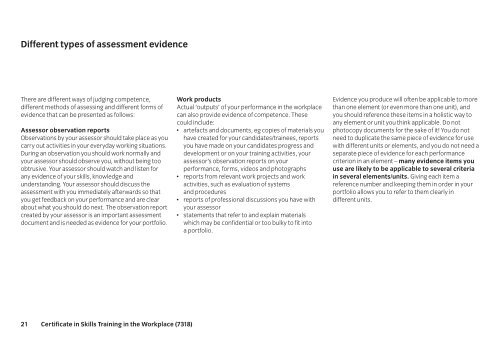Certificate in Skills Training in the Workplace (7318) - City & Guilds
Certificate in Skills Training in the Workplace (7318) - City & Guilds
Certificate in Skills Training in the Workplace (7318) - City & Guilds
You also want an ePaper? Increase the reach of your titles
YUMPU automatically turns print PDFs into web optimized ePapers that Google loves.
Different types of assessment evidence<br />
There are different ways of judg<strong>in</strong>g competence,<br />
different methods of assess<strong>in</strong>g and different forms of<br />
evidence that can be presented as follows:<br />
Assessor observation reports<br />
Observations by your assessor should take place as you<br />
carry out activities <strong>in</strong> your everyday work<strong>in</strong>g situations.<br />
Dur<strong>in</strong>g an observation you should work normally and<br />
your assessor should observe you, without be<strong>in</strong>g too<br />
obtrusive. Your assessor should watch and listen for<br />
any evidence of your skills, knowledge and<br />
understand<strong>in</strong>g. Your assessor should discuss <strong>the</strong><br />
assessment with you immediately afterwards so that<br />
you get feedback on your performance and are clear<br />
about what you should do next. The observation report<br />
created by your assessor is an important assessment<br />
document and is needed as evidence for your portfolio.<br />
Work products<br />
Actual ‘outputs’ of your performance <strong>in</strong> <strong>the</strong> workplace<br />
can also provide evidence of competence. These<br />
could <strong>in</strong>clude:<br />
• artefacts and documents, eg copies of materials you<br />
have created for your candidates/tra<strong>in</strong>ees, reports<br />
you have made on your candidates progress and<br />
development or on your tra<strong>in</strong><strong>in</strong>g activities, your<br />
assessor’s observation reports on your<br />
performance, forms, videos and photographs<br />
• reports from relevant work projects and work<br />
activities, such as evaluation of systems<br />
and procedures<br />
• reports of professional discussions you have with<br />
your assessor<br />
• statements that refer to and expla<strong>in</strong> materials<br />
which may be confidential or too bulky to fit <strong>in</strong>to<br />
a portfolio.<br />
Evidence you produce will often be applicable to more<br />
than one element (or even more than one unit), and<br />
you should reference <strong>the</strong>se items <strong>in</strong> a holistic way to<br />
any element or unit you th<strong>in</strong>k applicable. Do not<br />
photocopy documents for <strong>the</strong> sake of it! You do not<br />
need to duplicate <strong>the</strong> same piece of evidence for use<br />
with different units or elements, and you do not need a<br />
separate piece of evidence for each performance<br />
criterion <strong>in</strong> an element – many evidence items you<br />
use are likely to be applicable to several criteria<br />
<strong>in</strong> several elements/units. Giv<strong>in</strong>g each item a<br />
reference number and keep<strong>in</strong>g <strong>the</strong>m <strong>in</strong> order <strong>in</strong> your<br />
portfolio allows you to refer to <strong>the</strong>m clearly <strong>in</strong><br />
different units.<br />
21 <strong>Certificate</strong> <strong>in</strong> <strong>Skills</strong> Tra<strong>in</strong><strong>in</strong>g <strong>in</strong> <strong>the</strong> <strong>Workplace</strong> (<strong>7318</strong>)
















